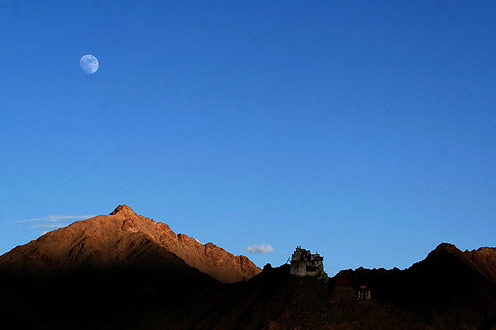Ladakh Chronicles
I am starting a travelogue series on Ladakh in the coming week, covering nearly all the important places in the region. A few interesting things that happened over the two months I spent, before we begin the series.
Namgyal Tsemo Monastery, Leh, Ladakh
* Arriving in Leh with just Rs.50 in hand close to midnight. The taxi driver wants Rs.150 to take us to the guesthouse. Take us through an ATM, we tell him. The first ATM we visit is not working, and so is the second. They are the only ATMs in town. We get dropped off anyway, and he collects the money next afternoon. Yes, thankfully one of the ATMs started working next morning or we would not know what to do.
* On the way up to Khardungla on public transport, a lady suddenly gets hysteric. First, it seemed like a terrible case of sneezing with some strange accent built on it! She went on for a long time. Her face looked terrible, her body shook and her hands had came together and vibrated badly. I thought she had suddenly gone sick and unable to bear the pain. But the women sitting next to her, probably her companions, appeared calm. The driver continued driving, climbing higher. She stopped as soon as the bus got to Khardungla. It turns out, she was praying.
* On the way to Lamayuru from Leh, the bus stops early in the morning, thanks to heavy rains that have caused a landslide. A bridge has broken down a little ahead, as a small stream has turned into a raging torrent that is consuming everything on its way. Not knowing what to do, we decide to wait and watch. We walked into a restaurant nearby for some breakfast. But they don’t have much to offer. There is no water because it is raining, tells the man who is attending the place. It took some time for me to understand what he meant. No water because of the rains? Ladakhis rely on their streams for their potable water. The stream was running muddy and violent today, depriving people of their source of clean water.
* We are crossing a stream on a mighty Bullet Thunderbird that weighs more than thrice as much as I weigh. There is no bridge or even an easy section of the stream to wade past. It is full of rocks, and the way is all ups and downs. We are stuck halfway and the bike refuses to go forward how much ever I accelerate. And it keeps getting turned off every minute as soon as I try to accelerate hard. We are stuck. The crazy stream, just about a feet high water, is known to raise to chest level with progress of the day. Are we going to have to let the bike drown here, or even worse, let it get carried away with the force of the water? We must have spent more than thirty minutes struggling get the bike out.
* Entertaining road signs from the creative folks at BRO. “Gati yane durgati”, “Life is short, don’t make it shorter”
* We are on the long bus ride to Zanskar that takes two days. The bus stops at everyone’s request on the way, even if a passengers or two intend to have a long chat with someone in a village on the way. Sometime in later half of the second day, a stop takes really long. As the minutes go by, more and more people get down for a walk, or to figure out what is going on. Some people from the bus are bartering their stuff with Yak’s curd at the village. And a tasting session also follows. Most people in the bus are now out to get their share. And a little later, someone comes into the bus with a container full of it, and distributes a little to everyone. Fifteen minutes of fun.
* After six days of walking in Zanskar, we meet our big challenge. An icy stream that we don’t want to cross. It is muddy and flowing fast, so we don’t know how deep is it, and if we can risk it. Our horseman cum guide – Brij Lal – urges us to go forward. But we wait for him to show us the way. Let’s cross behind him, we decide. He lets the horses go first, the beasts have absolutely no trouble. As the last of the horses is about to leave, something we never expected happens. Brij Lal jumps over one of the last horse, not really sitting on it but hanging behind and holding to the ropes tied on the horse. Before know what is happening, he has crossed to the other side safe and dry. And we are left wondering what to do!
It was a very exciting trip. I can’t to wait to share the stories!


